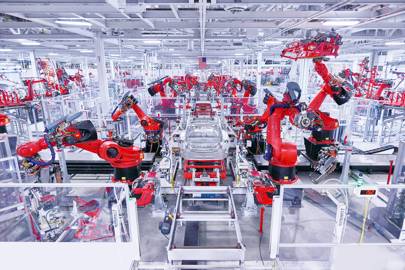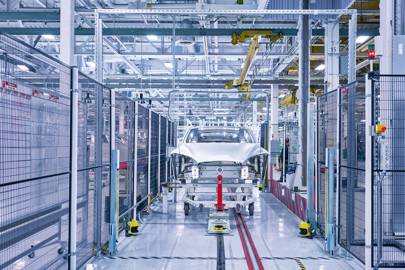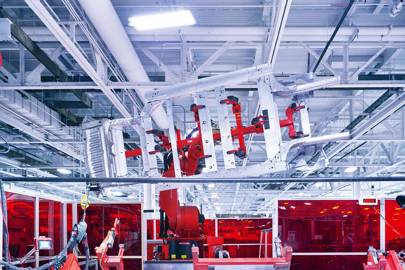
A troop of Kuka robots work on a Model S at Tesla
Elon Musk looks tired. There are bags under his eyes and an embattled admittance of disappointment has replaced the billionaire entrepreneur’s typical exuberance. A big, yellow strapline reads "PRODUCTION HELL" and CBS This Morning co-host Gayle King appears surprised as Musk agrees with every one of her questions that suggests Tesla hasn't been performing as well as it should.
During the eight-minute exclusive tour of his enormous Giga Factory in Silicon Valley, Musk is asked why it's producing just 2,000 Model 3s a week, as opposed to the 5,000 a week he promised at launch. He simply nods and admits: "I need to work out how we can be better and get better at meeting goals.”
Fair enough. But he then goes on to point out the conference room he sleeps in overnight while he sorts out the myriad issues facing the company. A billionaire business owner sleeping on a sofa above a factory floor: admirable behaviour or a sign of desperation?
It looks like investors haven't been too impressed by Tesla's recent performance, either. In late March, the company's share prince plunged after it announced a voluntary recall of 123,000 Model S vehicles. On Tuesday April 17, the company's share price continued to wobble after it said it would temporarily halt production of its mid-priced, mass produced Model 3 to "address bottlenecks" in its production line.
"Our Model 3 production plan includes periods of planned downtime in both Fremont and Gigafactory 1," a Tesla spokesperson said at the time. "These periods are used to improve automation and systematically address bottlenecks in order to increase production rates. This is not unusual and is in fact common in production ramps like this.”
However, the latest closure makes it the second temporary shut down since February, and although, as previously stated, this is nothing completely new in the automotive industry, it is yet another black mark on a company that has been under fire for production, quality and autonomous driving issues since its very first car.
"It was always a huge task to scale up from being a low-volume producer of luxury cars to a big player in the mass-market electric vehicle sector,” explains David Bailey, an expert on economic restructuring and industrial policy at Aston Business School in Birmingham.
“Tesla has been a pioneer in technology and a trailblazer in the electric vehicle market, but it has limited knowledge in the manufacturing process, and to go it alone could spell trouble for the company. The Model 3 is potentially a make or break scenario for Tesla, and if it can't prove to its investors that it can scale up and make significant profit, it could spell bad news,” he adds.
Aside from production mishaps, the list of fires Tesla is currently putting out continues to grow, with the company defending its position after a recent fatality involving its Autopilot semi-autonomous driving features – the second death surrounding this technology in recent years following a crash in May 2016 involving a Model S.
On top of this, Musk is addressing build quality issues that have been raised by customers and critics, with the likes of JD Power, one of the most influential consumer guides in the world, complaining of faulty door handles and excessive body panel gaps.
Plus, recent allegations raised by Reveal and The Center for Investigative Reporting claim that Musk's company concealed the true number of workplace injuries at its Fremont, California assembly plant in an attempt to put a positive spin on safety numbers and divert some of the negative press surrounding the company.
But as the fire continues to spread, the entrepreneur is seemingly employing the tactic of giving as good as he gets, branding Reveal an “extremist organisation” that “harassed” his workers by “phone or social media or even in the parking lot of the factory” in a statement on the company's blog.
Musk also reportedly yelled "shame" at a group of journalists on a conference call that dared to allege recent performance-related firings of hundreds of employees was to "disrupt possible unionisation efforts".
His blustering, almost Trump-like reactions on social media speak volumes of the gulf that separates Tesla and the more established automakers of this world.
Instead of engaging in online social disputes or writing ranting blogs on the company website, traditional OEMs are busy lubricating a well-oiled PR machine that makes finding a spokesperson to comment on an article such as the one you are reading near impossible. They simply don't want to get involved.
"Musk is a fantastic marketer, and the reason why his investors have been so patient up to this point is mainly down to his actions," explains Bailey. "But Tesla should learn from the larger OEMs about transparency, the way Toyota fell on its sword over its numerous recall issues, for example. Musk has to start being more accountable and improve on the way he communicates with the outside world if the company is to be a big player in the volume market.”
Getting it right first time

In a recent 'digital day' hosted by BMW to showcase some of its future innovations, Klaus Fröhlich, member of the Board of Management of BMW AG, said that he didn't want the widespread implementation of 5G networks in the auto sector to be used as a conduit for continuous over-the-air “patching” of systems and features.
"We want to get our products right first time," he said while joined by fellow member of the board Peter Schwarzenbauer. "Customers should not expect to receive lots of patches and updates on their vehicles like they do with some other manufacturers, we want to release a product when it is ready," he added.
Although many Tesla customers have enjoyed unlocking new features on their cars, should the wider car-buying public really play guinea pig to test systems that aren't quite ready?
"The Model X should have been a turning point for Tesla, but it got a lot of things wrong there, too," explains Mike Ramsey, automotive analyst at Gartner and former automotive journalist for the likes of Bloomberg and The Wall Street Journal. "It was rushed out to meet production deadlines, which meant customers had to wait for updates to access the full functionality," he adds.
OEMs have historically been slow to react and too corporate in their approach to car making, but more than 100 years of experience suggests that slow and steady can help win the race and the trust of its customers, certainly when it comes to safety.
In 2016, following the death of a Tesla driver in Florida, Tesla had to introduce new safety functionality, such as shutting off Autopilot if the driver's hands are off the wheel too long, after the US National Transportation Safety Board claimed Tesla "lacked understanding" of Autopilot's limitations.
"I was on one of the original calls when Musk announced some of the Autopilot features on the Model S," explains Ramsey. "It wasn't sold as a comfort feature or an additional safety device, this was sold as a fully hands-off system that could be used on the highway and everyone was sceptical back then.”
"They also didn't want to spend a lot of money, so much of the system used off-the-shelf parts and additional software, which every other manufacturer could also do at the time but chose not to because they didn't want their customers thinking these cars could actually drive themselves," he adds.
Production problems
To help Tesla meet the self-imposed Model 3 targets, it recently invested in Germany’s Grohmann Engineering, an experienced automation expert that would be brought in to “build the machines that build the machine”, as Musk put it at the time.
The move would see much of the Model 3 build process handled by robots, which is not uncommon in the advanced production lines of this world, but industry insiders claim this overly aggressive move is costing Tesla time and money. Business Insider UK reported that Wall Street analysts have condemned Tesla's attempt to automate the final assembly process in a move to speed up production.
"The Japanese style of production is to try and limit automation initially as it is expensive and statistically inversely correlated to quality," explains Benny Daniel, vice president of consulting on Mobility in Europe for Frost & Sullivan. "The approach is to get the process right first, then bring in the robots, basically the opposite of what Musk did.”
A sentiment that is echoed by Gartner’s automotive analyst Ramsey, who explains that Tesla is attempting to produce its Model 3 using prototype tooling, rather than testing its abilities first. "It's the start-up mentality again," he says. "Tesla takes the approach of trying something and then fixing it when it doesn't work, rather than testing before committing," he adds.
It is another example of a lack of experience, and possibly research, seeing as aggressive automation has been attempted by the likes of Volkswagen and Fiat in the past but ultimately failed.
After great expense, Musk now admits this and took to Twitter to say: “Yes, excessive automation at Tesla was a mistake. To be precise, my mistake. Humans are underrated.”
"Another subject that isn't being broached is Tesla's experience with steel," explains Bailey. "Its previous models used copious amounts of aluminium, but to cut costs the Model 3 uses steel and that requires a completely different set of manufacturing knowledge. Collaboration with experts in this field could have saved a lot of the confusion and downtime.”
A solution?

A perfect storm of tough, self-imposed deadlines, inexperience in the manufacturing process and a PR strategy that aggressively defends its position in the face of criticism has lead to the predicament Tesla is currently facing.
In response, Musk announced that the Fremont plant would move to 24/7 operations to hit a new deadline of 6,000 Model 3s per week, according to an email sent out to employees. He also famously added his tips on how to improve productivity by walking out of meetings or ending phone calls that weren't relevant, as well as stating that any department that couldn't meet the targets he set would "need to have a very good explanation why not".
Elon Musk might be going through “production hell” right now, but it seems he is taking Winston Churchill's advice, which he has quoted in the past, to "just keep going". And that likely means a few more rough nights on the sofa in conference room above the shop floor.